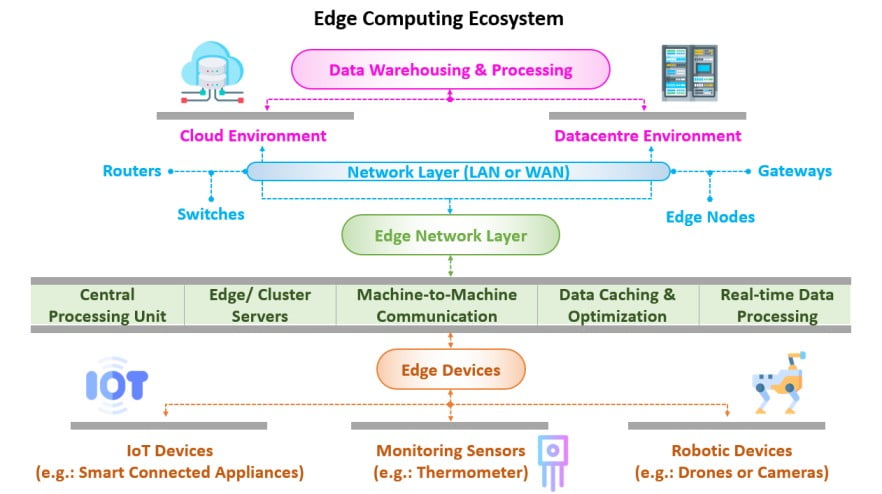
Overview:
In recent times, Edge Computing has emerged as a significant technological advancement, driven by the rapid growth of the Internet of Things (IoT) and the increasing demand for remote data processing. This technology focuses on enabling data processing and execution at the edge of the network, closer to the data source, rather than relying on centralized cloud data centers.
At the heart of Edge Computing lies a network of micro-data stations, which play a pivotal role in data storage and processing. By bringing computation closer to where data is generated, it allows for quicker response times and reduced latency. Moreover, Edge Computing aims to establish a level of independence from centralized cloud data centers, providing more resilient and efficient solutions.
This article aims to delve deeper into the world of Edge Computing, exploring various facets and applications of this technology. We’ll take a closer look at its significance in the context of the Internet of Things and how it’s shaping the future of data processing. Join us as we embark on this journey of discovery.
Contents:
- What is Edge Computing
- Understanding Edge Computing in a More Layman Language
- The Role of Network Edge in Edge Computing
- What Edge Computing Ecosystem Looks Like (The architecture world of Edge Computing)
- Key Components of Edge Computing System
- How Edge Computing is Different from On-prem/ Cloud/ Fog Computing Methodologies
- The Edge Computing Market Landscape
- Key Drivers Responsible for Edge Computing Growth
- Key Barriers Restricting Edge Computing Growth
- Key Application Areas of Edge Computing
- Key Benefits of Edge Computing
- Key Drawbacks of Edge Computing
- Key Recent Developments in Edge Computing in Prominent Economies
What is Edge Computing:
Edge computing entails the practice of decentralizing information storage and computational functions, positioning them closer to both the devices generating data and the end-users who rely on it. By doing so, edge computing narrows the role of the cloud and networks, as it runs most processing operations to local locations. These locations might encompass a user’s personal device, often an Internet of Things (IoT) device or an edge server. Only essential processes are conveyed to the cloud or a central data center.
Historically, data generated by smart devices, like sensors and smartphones, was transmitted to a centralized datacenter or server for processing before being relayed back to the user for insights. In contrast, edge computing empowers devices situated in remote areas to process data at the network’s periphery, offering instant insights to users.
The ever-increasing volumes of data and the demand for immediate actionable insights have disrupted the established paradigm. They’ve driven the relocation of operational capabilities closer to users and devices. By bringing computation to the network’s edge, the need for extensive long-distance communication between clients and servers is minimized. As a result, edge computing systems significantly enhance application performance, decrease bandwidth demands, and deliver quicker real-time insights.
Let’s Understand Edge Computing in a More Layman Language:
In a distant warehouse, a security camera operates continuously, diligently monitoring its surroundings. During this ongoing operation, it consumes a substantial amount of operational and computational resources, imposing a constant burden on the security monitoring system. However, when this very security camera harnesses the power of artificial intelligence (AI) to detect suspicious activities, it becomes more judicious. Instead of continually transmitting the whole video feed to the central data center around the clock, the camera selectively forwards only relevant video clips for processing.
This intelligent approach lightens the strain on the network, conserving bandwidth and computational resources that can be deployed elsewhere. In this manner, the security camera, enhanced with AI capabilities, transforms into an Edge Device, supporting the architecture of Edge Computing.
The Role of Network Edge in the Edge Computing:
The network edge serves as the outermost layer of a network, where it interfaces with end-user devices like modems, smartphones, and IoT devices. It’s the zone where data is both generated and utilized by users in the tangible, real-world environment. In contrast, edge computing involves strategically situating computing capabilities and data storage in proximity to this network edge, primarily to enhance the performance of real-time services. The network edge essentially denotes the juncture where the network converges with the physical world and the internet, constituting a specific geographical point of connection.
What Edge Computing Ecosystem Looks Like (The architecture world of Edge Computing):

Key Components of Edge Computing System:
1. Edge Devices Layer
This layer encompasses a wide array of intelligent, connected IoT devices like smart appliances, monitoring sensors such as thermometers, and robotic gadgets including drones or smart cameras. A substantial number of these edge devices are equipped with integrated computing, memory, and storage capacities that effectively support the edge ecosystem, lightening the central processing system from any supplementary burdens.
2. Edge Network Layer
The edge network layer serves as the foundation for central processors like CPUs or GPUs, along with their associated memory, which serve as the driving force behind edge computing systems. This layer also incorporates edge clusters/servers situated at edge locations. These edge clusters/servers are tasked with the execution of applications and workloads on shared services. Moreover, the technologies associated with this layer, including M2M communication, data caching, and real-time processing, cater to the fundamental requirements of edge computing.
3. Network Layer
The network layer acts as the bridge between the Edge and the central Cloud/Database environment. It typically encompasses various LAN and WAN topologies, incorporating Gateways that play a crucial role in essential network functions. These functions include enabling wireless connectivity, offering firewall protection, and managing the processing and transmission of data from edge devices. This layer also comprises Routers, responsible for connecting LAN networks and subsequently linking them to a WAN or the internet. It involves Switches to facilitate the connection of multiple devices, thereby forming a comprehensive network. Additionally, other Edge Nodes are vital components in fulfilling the network prerequisites necessary for the implementation of edge computing.
4. Data Warehousing & Processing Layer
The data warehousing & processing layer encompasses both a conventional cloud configuration and a data center setup. Historically, these setups were employed for cloud computing, with data from the edge devices being transferred to the cloud or data center for processing before sending insights back to the edge. However, the arrival of edge computing has altered this flow of operations, rendering this layer a supporting component that complements the edge computing ecosystem.
How Edge Computing is Different from On-prem/ Cloud/ Fog Computing Methodologies:
| Particulars | On-prem Computing | Cloud Computing | Edge Computing | Fog Computing |
| Architectural View | On-premises computing entails storing hardware, software, and data at a physical location, enabling convenient access to data from a single site | Cloud computing centralizes data storage and provides access over the internet. This allows data to be collected from various locations and devices, making it available from anywhere at any time | Edge computing processes data closer to the data sources instead of sending it all back to the cloud for analysis and action, reducing the backhaul traffic to the central repository | Fog computing, similar to edge computing, extends cloud computing to the edge of a network. However, it distributes intelligence to the LAN and processes data within a fog node or gateway |
| Application Schema | Applications are centrally hosted on an on-premises facility, typically a central server | Applications are centrally hosted in a data center where the cloud is hosted, rather than running on-premises | Applications operate in proximity to users, either on the device itself or at the network edge | Applications operate in the vicinity of users on a LAN and handle data processing within a fog node or gateway |
The Edge Computing Market Landscape:
According to the Worldwide Edge Spending Guide published by International Data Corporation (IDC), global spending on edge computing is anticipated to reach USD 208 Billion in 2023, marking a 13.1% year-on-year increase, and is projected to reach USD 317 Billion by 2026.
In terms of geographical distribution, the United States is poised to dominate the edge computing market between 2023 and 2026, contributing to over 40% of the total global expenditure, closely followed by Western Europe and China. Furthermore, Latin America and China are expected to experience the most rapid growth in spending over the five-year forecast, with impressive compound annual growth rates (CAGRs) of 18.1% and 18.0%, respectively. Notably, China is set to lead in edge computing spending throughout the forecast period, accounting for more than 70% of the total regional spending with a robust five-year CAGR of 17.5%.
Key Drivers Responsible for Edge Computing Growth
1. Growing IoT Applications and Devices
As the Internet of Things (IoT) continues to expand its presence, the edge computing market is poised for substantial growth. The proliferation of IoT devices has prompted the demand for swift and efficient data processing at the network’s edge.
2. Increasing Number of Smart City Projects
Contemporary smart cities rely on a range of real-time insight mechanisms, necessitating extensive data processing and analysis. This is fundamental for the effective and sustainable administration of urban infrastructure, thereby driving forward the field of edge computing.
3. Rising Demand for Low-Latency Processing
Edge computing is primarily founded on the concept of processing data at the network’s edge to enhance its low-latency processing requirements. This focus on low-latency processing becomes especially vital for applications like autonomous vehicles, where real-time decision-making capabilities are indispensable.
4. Development in the Adjacent Supportive Technologies
Adjacent technologies like 5G networks, artificial intelligence (AI), and machine learning (ML) are anticipated to play a pivotal role in driving the growth of the edge computing market. These technologies facilitate swifter and more efficient data processing, a critical requirement for the success of edge computing.
Key Barriers Restricting Edge Computing Growth
1. Increasing CAPEX Challenges
Investing in edge infrastructure can significantly impact a company’s capital expenditures (CAPEX). Consequently, many companies are exploring comprehensive edge computing solutions, which may necessitate substantial investments in edge data centers, edge devices, and edge nodes.
2. Distributed Computing Architecture
Typically, in traditional servers, modules are distributed across considerable distances from one another. In contrast, edge computing aims to consolidate these systems closer to the computational areas. However, this shift can lead to conflicts, as business servers must now account for the presence of the edge server as an additional factor during computation.
3. Security and Encryption Issues
Every device within an edge server introduces another potential vulnerability, particularly in the context of the Internet of Things (IoT), which is known for its inadequate security measures. Moreover, smaller data centers, such as embedded devices, often lack robust security measures and do not receive the necessary updates as frequently as required.
4. Operational and Logistics Constraints
The presence of numerous edge receivers distributed at specific distances from the data center complicates the troubleshooting and repair process in the system. This adds logistical challenges and requires substantial manual intervention, ultimately leading to an increase in maintenance costs.
5. Data Gathering and Management
Gathering large volumes of data at either the edge server data center or the edge node presents numerous security and accessibility challenges. Moreover, the transmission of substantial data quantities necessitates the development of innovative techniques, which are still in the research phase.
6. Moving System Constraints
The majority of devices utilizing edge computing, including mobile devices, laptops, in-ear monitors, as well as wireless earphones, are typically part of a mobile environment or closely associated with individuals. Enabling data exchange, ensuring security, and providing access to the cloud/internet while in a mobile state poses a significant challenge that must be addressed.
Key Application Areas of Edge Computing:
1. Manufacturing Operations
Manufacturers harness edge computing solutions to achieve automation, gather on-site data, enhance production efficiency, and facilitate swift machine-to-machine communication. Sensors deployed on the factory premises serve the purpose of monitoring equipment for routine maintenance needs and identifying malfunctions, all while ensuring the safety of workers. By retaining data and analysis within the factory environment rather than transmitting it to a centralized data center, this approach can effectively avert costly delays and potential hazards.
2. Healthcare Procedures
Edge computing has found extensive applications in the healthcare sector. Edge devices play a crucial role in monitoring vital patient parameters like temperature and blood sugar levels. Leveraging edge computing, healthcare providers can securely store this patient data at local levels, thereby enhancing privacy safeguards. Moreover, medical facilities can significantly reduce the volume of data transmitted to centralized hubs, mitigating the risks of data loss.
Furthermore, temperature sensors embedded within vaccine shipments contribute to ensuring the integrity of vaccines throughout the entire supply chain. In the realm of robotic-assisted surgery, the implementation of edge computing results in numerous subtle yet collectively impactful changes. These alterations enable surgeons to benefit from an improved field of vision, as well as the use of controls that are more intuitive and natural.
3. Retail Augmentation
Major retailers regularly accumulate substantial volumes of data within each of their individual stores. Edge computing offers a powerful solution that empowers retailers to extract more comprehensive business insights and respond to them instantaneously. For instance, retailers can capture data on customer foot traffic, closely monitor point-of-sale figures, and assess the effectiveness of promotional initiatives across their various store locations. Leveraging this localized data enables retailers to optimize inventory management, fostering quicker and more well-informed business decisions.
4. Energy Utility
Power and utility companies are harnessing the capabilities of IoT sensors and edge computing to enhance operational efficiency, automate power grids, streamline maintenance procedures, and address challenges related to network connectivity in remote locations. Various energy sources like utility towers, wind farms, and oil rigs are outfitted with resilient IoT devices designed to withstand extreme weather conditions and environmental factors. These devices facilitate on-site or nearby data processing, transmitting only the most pertinent information to the central data center.
In the oil and petrol sectors, IoT sensors and edge computing play a pivotal role in delivering real-time safety alerts, promptly notifying key personnel of crucial maintenance requirements and potential equipment malfunctions, which, if left unattended, could result in catastrophic incidents such as explosions.
Furthermore, energy companies employ edge computing to gather and store data from diverse sources including oil rigs, gas fields, wind turbines, and solar farms. Rig operators commonly deploy edge artificial intelligence to detect hazards, optimize operations, and inspect pipelines. By embracing edge computing, the energy industry enhances operational efficiency, prioritizes worker safety, and accurately forecasts maintenance schedules.
5. Agriculture Monitoring
Edge computing has the potential to enhance agricultural productivity and crop yields significantly. By deploying resilient IoT sensors and drones capable of withstanding various weather conditions, farmers can effectively monitor equipment temperature and performance. They can also collect data on crucial environmental factors such as soil quality, light levels, and more. This valuable data enables farmers to optimize irrigation and nutrient application, resulting in resource-efficient farming practices. Additionally, edge computing allows for precise timing of harvests, contributing to more efficient crop management. Even in remote agricultural locations with limited network connectivity, edge computing renders the utilization of IoT technology cost-effective and feasible.
6. Automobile Maneuvering
Self-driving vehicles, including cars, taxis, vans, and trucks, operate within extremely narrow margins for error. They depend on edge computing to deliver immediate and precise responses to variables such as traffic signals, road conditions, obstacles, pedestrians, and other vehicles in real-time.
The nature of autonomous vehicles, like self-driving cars, demands real-time data processing for split-second decision-making. They cannot afford to rely on distant servers for such critical and instantaneous responses. Furthermore, autonomous vehicles exhibit greater efficiency when they establish direct communication with one another, rather than transmitting data related to weather, traffic, accidents, or detours to a remote server. Edge computing stands as a pivotal technology to ensure the safety of these vehicles and their capacity to make accurate judgments about road conditions.
7. Branch Offices
Smart devices and sensors play a crucial role in streamlining the operational efficiency of a company’s satellite offices. These include internet-connected HVAC controls, sensors that detect when copiers need maintenance, and security cameras. Edge computing comes into play by forwarding only the most critical alerts generated by these devices to the company’s central data center. This strategic approach prevents server congestion and eliminates lag time, substantially enhancing the response time to facility-related issues.
Key Benefits of Edge Computing:
1. Cost Savings
Edge computing enables businesses to streamline their IT expenditures by conducting data processing at local or edge locations, as opposed to relying solely on cloud resources. This approach not only reduces a company’s cloud-related processing and storage expenses but also trims transmission costs by filtering out superfluous data directly at, or in close proximity to, the data collection source.
2. Reduced Latency
Shifting processes to the edge significantly diminishes latency. When a device has to communicate with a remote server, it introduces delays. For instance, two colleagues conversing through an instant messaging platform within the same office may encounter noticeable delays as each message travels out of the building, connects with a server located far away, and returns to appear on the recipient’s screen. If these processes occur at the edge, with the company’s internal router managing intra-office chats, these delays become virtually non-existent.
3. Operational Efficiency
Edge computing enables enterprises to enhance their daily operations by swiftly handling substantial data volumes at or near the local sites where the data originates. This approach proves to be more efficient than transmitting all collected data to a centralized cloud or a primary data center located in a distant time zone. Such centralized processing often leads to significant network delays and performance challenges.
4. Faster Response
Edge computing avoids the need to rely on centralized cloud and data center locations. It empowers companies to process data rapidly and reliably, whether in real-time or close to it. Think about the network bottlenecks and potential data quality degradation when attempting to transmit information simultaneously from thousands of sensors, cameras, or other smart devices to a central office. In contrast, edge computing enables devices situated at or near the network’s edge to promptly notify essential personnel and equipment of mechanical breakdowns, security risks, and other critical incidents. This ensures that swift and decisive action can be taken.
5. Greater Productivity
Edge computing empowers businesses to expedite the delivery of essential data to their workforce, enhancing job efficiency. In smart workplaces that leverage automation and predictive maintenance, edge computing ensures seamless operation of the equipment necessary for workers, minimizing interruptions and preventing avoidable errors.
6. Remote Functionality
Edge computing simplifies the utilization of data acquired from remote sites with sporadic internet connectivity or restricted network bandwidth. Sensors can continuously monitor operational data, such as water or soil quality, and initiate actions as required. Once internet connectivity is reestablished, the pertinent data can be transmitted to a central data center for further processing and analysis.
7. Improved Safety
In workplaces where equipment malfunctions or alterations in working conditions pose potential risks to human safety, the combination of IoT sensors and edge computing plays a pivotal role in ensuring people’s well-being. In scenarios like offshore oil rigs, oil pipelines, and various other remote industrial settings, the implementation of predictive maintenance and real-time data analysis performed on-site or in close proximity to the equipment significantly enhances worker safety and reduces environmental risks.
8. Heightened Security
Enterprises often face the security challenge of incorporating a multitude of internet-connected sensors and devices into their networks. Edge computing serves as a valuable solution to address this concern by enabling local data processing and offline storage. This approach reduces the volume of data transmitted over the network, effectively enhancing security measures and making enterprises less susceptible to potential security threats.
9. Data sovereignty
Organizations dealing with the collection, processing, and storage of customer data are obligated to comply with data privacy regulations specific to the country or region in which the data is collected or stored. An example of such regulations is the European Union’s General Data Protection Regulation (GDPR). Transferring data to the cloud or a central data center situated across international borders can pose challenges in terms of adhering to data sovereignty regulations. However, with edge computing, businesses can effectively ensure compliance with local data sovereignty guidelines, as data is processed and stored in proximity to its source of collection. This approach simplifies the regulatory compliance process.
Key Drawbacks of Edge Computing:
1. Increases Vulnerability
The rise of smart devices, including edge servers and IoT devices, introduces new opportunities for potential security breaches. With these devices becoming increasingly interconnected and integral to various functions, there is a growing risk of malicious attacks. These devices are deployed in diverse settings, from industries to homes, making them vulnerable to security threats. Securing these edge devices is a pressing challenge, and robust cybersecurity measures are essential to protect them from exploitation and potential breaches.
2. Requires More Hardware
Edge Computing relies on dependable hardware support, whether that support is located remotely or locally. To illustrate this point, consider an IoT camera. This device necessitates a built-in computer to transmit its raw video data to a web server. However, for the camera to execute its motion-detection algorithms autonomously, it requires a more advanced and powerful computer with increased processing capabilities.
3. Lacks Global Standard
Edge computing demands the appropriate infrastructure, which encompasses a cloud provider, network architecture, and compatible devices to effectively support edge devices. In practice, many enterprises rely on a combination of various, sometimes incompatible technology stocks. The process of aligning these diverse technologies to enable optimal edge computing functionality can prove to be a formidable challenge.
4. Lacks Right Talent
Understanding edge computing can be a complex endeavor, particularly for companies already well-versed in cloud technology. Rather than undergoing a complete overhaul, the essence of edge computing lies in expanding existing capabilities to the edge of the network. Achieving this extension necessitates the expertise of individuals with specialized skills who can adeptly deploy the appropriate architectural solutions at the network’s edge.
Key Recent Developments in Edge Computing in Prominent Economies:
United States:
As per a report, it is projected that local and state governments in the Americas will allocate approximately USD 4.9 Billion for edge solutions by 2026, with the majority of this expenditure originating from the United States. (2023)
China:
In October 2023, China’s Ministry of Industry and Information Technology introduced a revised action plan focused on the “High-Quality Development of Computing Infrastructure.” This plan places significant emphasis on the expanded deployment of edge computing and the low-latency networks required to support it. (2023)
Japan:
Fujitsu, a leading Japanese ICT firm, has entered into a collaboration with Microsoft with the goal of establishing a seamless and secure connected society. This collaboration involves the integration of private 5G technology with edge computing. The objective is to create a unified platform capable of harmonizing all solutions, ranging from 5G base stations to edge applications. The platform aims to provide innovative services that deliver added value to customers and address societal challenges. (2023)
India:
embedUR systems, a United States-based company specializing in embedded technology, has outlined an investment plan of INR 500 Crore (approximately USD 60 Million) spanning five years in Chennai. This substantial investment is aimed at enhancing the company’s capabilities and expertise in crucial areas, including AI, Edge Computing, cybersecurity, and connectivity.
Image by svstudioart on Freepik












7 thoughts on “Deciphering the Vibrant World of Edge Computing”